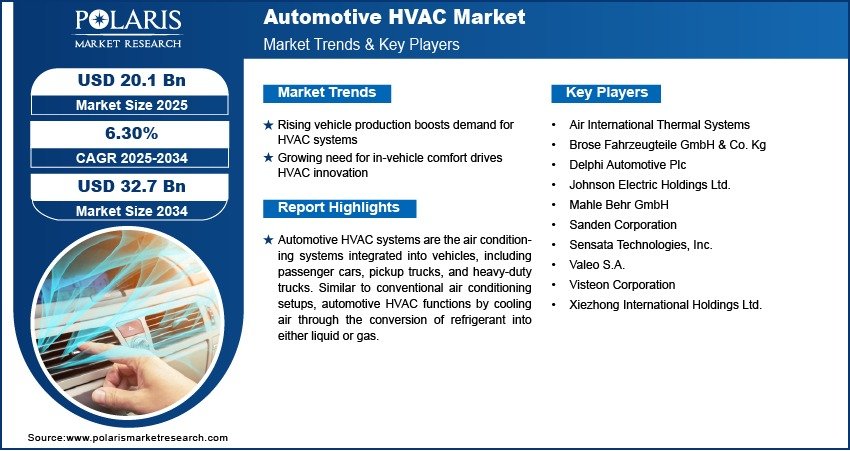Automotive HVAC Market Projected to Reach $32.7 Billion by 2034 | CAGR: 6.30%

Automotive HVAC Market: 2024 Valuation and Forecast to 2034
The global Automotive HVAC Market was valued at USD 18.9 billion in 2024 and is anticipated to witness a CAGR of 6.30% from 2025 to 2034. This growth is being fueled by rising demand for enhanced comfort in vehicles and the increasing adoption of electric vehicles (EVs). HVAC systems (Heating, Ventilation, and Air Conditioning) have become an essential component in automobiles to maintain cabin temperature, ensuring passenger comfort and improving overall vehicle performance.
Key Market Trends:
-
Growing Integration in Electric Vehicles: With the rise of EVs and hybrid vehicles, HVAC systems are being designed for higher energy efficiency and better compatibility with electric drivetrains.
-
Smart Climate Control Systems: OEMs are increasingly integrating IoT and AI-driven HVAC technologies for automatic climate adjustments and personalized user settings.
-
Thermal Management Innovation: Development of multi-zone climate control and eco-friendly refrigerants is gaining attention due to environmental concerns and regulatory pressure.
-
Increased Demand for Comfort and Safety: Consumer preference for improved in-car experiences and stringent regulations around driver safety are boosting HVAC installations even in mid-range and budget vehicles.
Market Size & Forecast:
|
Market size value in 2025 |
USD 20.1 billion |
|
Revenue forecast in 2034 |
USD 32.7 billion |
|
CAGR |
6.30% from 2025 – 2034 |
Request for Free Sample:
https://www.polarismarketresearch.com/industry-analysis/automotive-hvac-market/request-for-sample
Market Overview:
The automotive HVAC market is undergoing significant evolution, driven by technological advancements and changing consumer expectations. Previously considered a luxury feature, HVAC systems are now standard in most vehicle segments, including compact and economical models. Automakers are focusing on delivering energy-efficient and intelligent HVAC systems to reduce emissions and enhance fuel economy, especially critical in EVs.
In addition, the emergence of autonomous vehicles and shared mobility services is expected to create new opportunities for customized HVAC solutions. These systems must adapt to variable occupancy and usage patterns, which is leading to modular and adaptive designs.
Key Market Opportunities:
-
OEM Collaboration: Strategic partnerships between automakers and HVAC system manufacturers can accelerate innovation and integration of smart solutions.
-
Aftermarket Expansion: Demand for aftermarket HVAC components, especially in Asia-Pacific and Latin America, is creating new revenue streams.
-
Green Refrigerants: Regulations encouraging low-GWP (Global Warming Potential) refrigerants offer a path for sustainable innovation.
-
Autonomous and Connected Vehicles: These vehicles demand advanced HVAC systems that integrate with vehicle sensors and passenger data for intelligent thermal management.
Market Scope:
The global automotive HVAC market includes components such as compressors, condensers, evaporators, and control units, serving all vehicle types including passenger cars, light commercial vehicles, and heavy-duty vehicles. Regional growth is expected to be led by Asia-Pacific, driven by high vehicle production in China, India, and Japan, while North America and Europe will continue to demand high-tech, eco-friendly HVAC systems due to stricter emission norms and high EV penetration.With its 2024 valuation at USD 18.9 billion and strong projected growth, the Automotive HVAC Market represents a dynamic and expanding landscape, fueled by innovation, sustainability, and evolving mobility trends.






